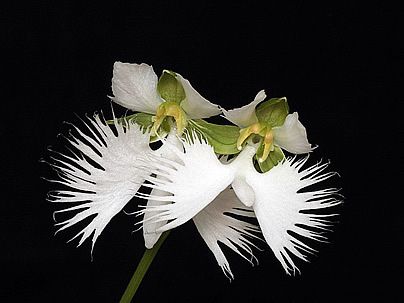A curious orchid in several aspects, that is the white egret flower (Pecteilis radiata), originating from the moist plains of China, Japan, and Korea. It is currently severely threatened with extinction, as its habitat has been taken over by rice fields and urbanization. It can be found in its native state, at altitudes above 500 meters, in rough and non-arable terrains remaining in Japan. Unlike the vast majority of orchids, which behave as perennials, the white egret flower has an annual cycle and, astonishingly, forms tuberous roots that allow it to regrow year after year!

In the spring and summer, erect, linear-lanceolate leaves grow, giving the plant a grassy appearance. In the summer, the flowers appear on stems above the foliage, ranging from one to eight per plant. During autumn, the plant begins to decline, the leaves wilt, and gradually new tuberous roots form along the rhizome. In the winter, the plant’s fine roots decompose, leaving one to three, and often more, light brown, ovoid, and fuzzy tubers that will give rise to new plants the following spring.
The delicate white flower of this orchid has a labellum divided into three lobes. Two fringed lateral lobes and a smooth central one pointing downwards. This magnificent ensemble is what gives the appearance of an egret in full flight, with open wings. The flower also features a long nectary, about eight centimeters (3.15 inches) in length, arched, green in color, below the labellum. A remarkable orchid!

Some consider this plant easy to cultivate, while others say it is quite difficult to develop. Indeed, due to so many differences, its management is unlike any other orchid we are accustomed to growing. For orchid enthusiasts on standby, it can be a tremendous challenge. However, for gardeners who already have experience with carnivorous plants, the management of the white egret flower may be considered easy, due to the similarities in the habitats of these different plants.
The climate also greatly influences the growth of this species, which prefers sunny locations, with high humidity and well-defined seasons to multiply and flower. Under tropical climates, it will be necessary to protect it from temperatures above 30°C (86°F) and especially from drought, which it does not tolerate for even a day. In this type of climate, winterizing the tubers should be carried out in a refrigerator.
It should be cultivated under full sun or partial shade, in live sphagnum or mixtures specific for carnivorous plants, and kept moist during the vegetative period of the orchid. In winter, when the plant goes dormant, the substrate should be kept dry so that the tubers remain healthy. At all times, take care not to waterlog the substrate, which requires aeration, thus avoiding diseases and rot.
The white egret flower does not tolerate the salinity of coastal regions. Fertilize with orchid-specific fertilizers, with micronutrients, preferably inorganic. Use rested water, free of chlorine and excess minerals during watering. It multiplies by separating the tubers that form in autumn/winter. Plant the new tubers one centimeter (about 0.4 inches) deep, with the pointed part facing upwards, as the first sprouts will emerge from there.


